Dyakonov's grenade launcher
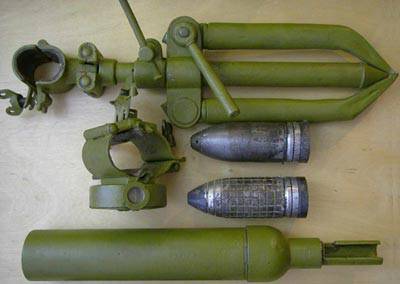
8 March 1916 was assigned to the headquarters captain of the 37 th Yekaterinburg regiment M. G. Dyakonov, who had been trained at the Military Automotive School to the rifle range of the Officer Rifle School "to demonstrate their inventions".
Dyakonov created a rifle grenade, which was fired from the barrel of a rifled mortar of its construction.
Mortirka Dyakonov was intended to be mounted on the muzzle of a Mosin rifle arr. 1891 of the year. The mortar barrel was made of seamless steel pipe and had a caliber 41 mm.
The rifled mortar and fragmentation grenade of the staff captain of the 37 th Ekaterinburg regiment M. G. Dyakonov turned out to be the most successful designs. 24 December 1916, they were tested on the South-Western Front, and for the needs of the army 40 000 mortar and 6 125 000 grenades were ordered.
They even managed to adopt the mortuer and the grenade, but they didn’t have time to put it into production, since 1 March 1918, all the work was curtailed due to "demobilization of industry".
In the 1920-ies Dyakonov construction grenade launcher was adopted by the Red Army.
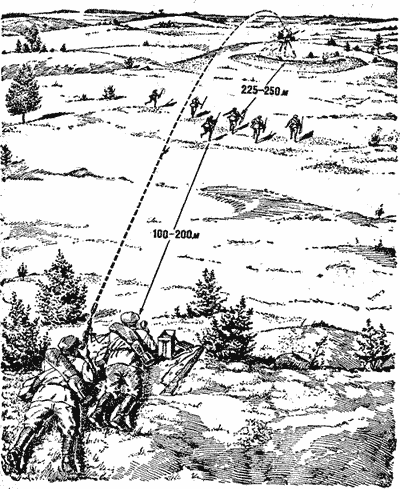
shooting from a Dyakonov rifle grenade launcher
In the period 1920-30-ies of the Deacons continuously improved the grenade launcher and its ammunition.
In the Soviet period, a tube and an extra charge appeared in the bottom of the grenade in a grenade launcher and it got a more streamlined shape with a reviving.
From the Dyakonov's rifle grenade launcher, which is in service with the Red Army, it was possible to fire at a distance from 150 to 850 meters. The rifle grenades fly along a steep trajectory (much steeper than bullets) and therefore fall behind the closures.
The Dyakonov's grenade launcher was successfully used both in defense and in the attack to defeat clusters of enemy personnel and its firing points in trenches, closures and dead spaces, in approaches, etc., where the enemy was hiding from the fire of rifles and machine guns.
The assembled rifle grenade launcher weighs about 8 kilograms. It consists of an ordinary 7,62-millimeter rifle, on the muzzle of which a rifle mortar is worn (the bayonet is removed).
A rifle grenade was used to fire a rifle grenade launcher.
A rifle grenade when firing is embedded in the barrel mortars. In order for the grenade to get shot, it rotates around its axis (like the bullet), the mortar barrel has 3 rifles along which the leading protrusions of the grenade go. The rear end of the barrel is screwed tightly into the connecting cup, and the neck is screwed into the rear end of the connecting cup. The neck has a channel for putting on the barrel of a rifle and a crank slot to attach to the base of the front sight.
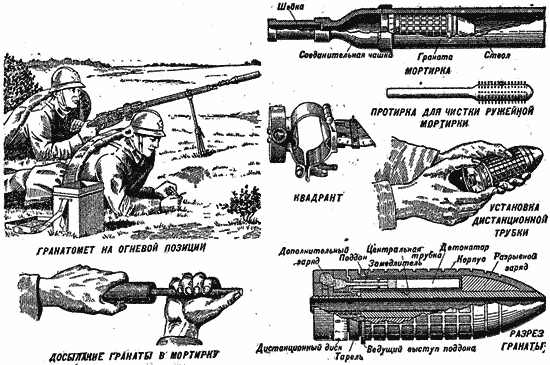
rifle grenade launcher and Dyakonov grenade
To give the rifle a stable position when firing at different angles of elevation, the bipod serves. When you install a grenade launcher for firing sharp ends of the legs of the bipod stuck into the ground. At the bipod stand reinforced holder, which is inserted into the rifle. In this case, the clip can be fixed with a clip at any height.
For aiming a rifle grenade launcher at the target serves as a protractor-quadrant, which is attached to the rifle with a clamp. A quadrant box is attached to the left side of the clamp, and a goniometer with a sight line is attached to the right side. The quadrant serves to give the grenade launcher the desired angle of elevation, and the protractor in order to send the grenade launcher at the target, using the slot and front sight sight line.
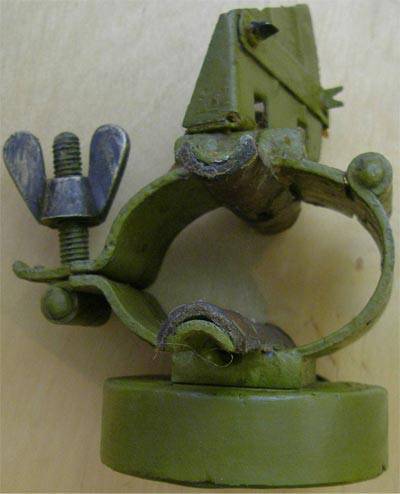
Dyakonov grenade launcher quadrant
A rifle grenade is a small shell weighing about 370 grams; it consists of a steel case, closed bottom pallet. Outside, the body is cut grooves into separate squares to make it easier to break. Along the entire body of the grenade there passes a central tube, which serves to pass the bullet. Inside the case is placed a bursting charge. It consists of 50 grams of high explosive. A remote tube is fixed at the rear end of the central tube, which serves to blast the grenade over the target at various distances. The installation of a grenade on a gap is made by turning a special remote disk (with divisions). To increase the firing range, a grenade has an additional expelling charge consisting of 2,5 grams of smokeless powder poured into a silk bag. This charge is glued to the bottom of the grenade. Exploding at the time of the shot, it increases the pressure of the powder gases to the bottom of the grenade, and, consequently, the firing range.
To protect it from moisture, a grenade rifle is screwed hermetically into a special cap.
Shooting from a rifle grenade is ordinary combat rifle cartridges.
Before putting the grenade into the mortar blade, the outer cap is unscrewed and the grenade is released from it. Then the remote tube is placed on the desired range.
In a charged grenade launcher, a rifle grenade, sent to the bottom of the mortar, stands with a hole in the center tube against the rifle barrel.
When fired, the bullet of the combat rifle cartridge flies out of the muzzle of the rifle and, falling into the central tube of the grenade, flies through it, like a barrel. Following the bullet into the connecting cup of the mortar, elastic hot powder gases of the rifle cartridge rush in and forcefully push the grenade into the bottom. If the extra charge that the grenade has been torn out, then the grenade can fly a distance of 300 meters. If the charge was left, then the grenade will fly up to 850 meters.
When hot gases strike the bottom of the grenade, fire ignites the powder in the groove of the remote disk. During the flight of the grenade to the target, the fire gradually burns gunpowder in the groove of the disk and passes into the tube of the detonator, burns the powder retarder and detonates the detonator and the whole grenade. A grenade breaks at a certain distance.
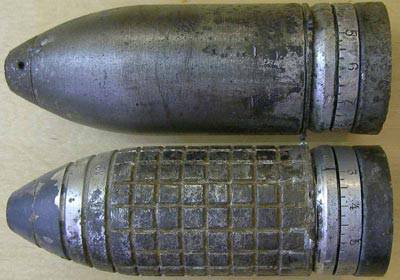
Dyakonov's grenade
When a grenade explodes, it turns out 330-340 steel fragments, which hit at a distance of 150 meters from the explosion. Therefore, when firing at a distance of up to 150 meters, the grenade throwers should have covered themselves well, so that they would not be hit by fragments.
The grenade launcher serviced the 2 fighter: the grenade thrower and his assistant.
When firing rifle grenades get a very big return, so the rifle butt can only rest on the ground; if you push it against your shoulder, it can break the collarbone. To stop the rifle butt in the ground digging a hole. In winter, a butt is enclosed under the butt, in addition, a special pad so that the rifle bed does not crack when firing; it is impossible to rest the rifle butt against a stone or into frozen ground.
When loading grenade rifle shutter should be opened to avoid accidental firing.
Putting a grenade into the muzzle of the mortar, you need to ensure that the leading protrusions are included in the grooves. When a grenade is inserted, it will be sent as a bannik to the bottom of the mortar, otherwise there will be a sharp undershoot.
After the 50-60 shots in a row, the tail screw and the screw of the rifle are checked with a screwdriver, which are unscrewed from the recoil.
When shooting, watch where grenades are torn. Grenades best hit the target if they burst no higher than 5 meters, and hit the ground poorly. If the grenades are torn high and closer to the target, then they add the tube (by a quarter or half a second), then the grenades will burst lower and farther. If the undershoots still continue, add an angle of 1-2 degrees. When flying, turn down the angle (in quadrant) so that the grenades fall at the target, then turn down the receiver to lift the gaps above the target. If the grenades fall well, then shoot at the highest possible speed until the target is completely hit.
Before World War II, the grenade launcher was recognized as insufficiently effective and the production of Dyakonov grenade launchers was discontinued.
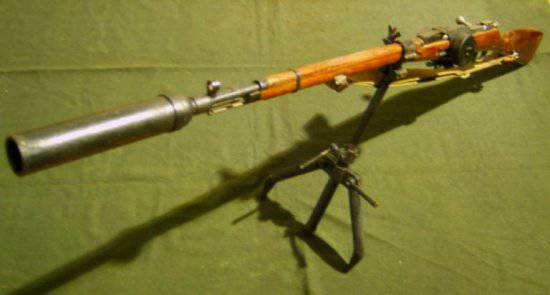
Information